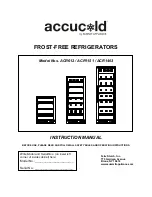
Instructions for Use
50
Placing and Installation
Choosing the Right Place
Place the appliance in a dry and regulariy
ventilated room. Allowed ambient temperature
depends on the model (class) of the appliance
and is stated on the rating plate of the appliance.
Never place the appliance near heat emitting
devices (e.g. cooker, radiator, water heater or
similar devices) and do not expose it to direct
sunlight.
The appliance should be positioned at least 3 cm
away from the electric or gas cooker and at least
30 cm away from the oil or coal stove. If this is
not possible, use an appropriate insulation.
Behind the appliance there should be free space
at least 200 cm
2
wide and above the appliance
the high kitchen units should be at least 5 cm
away from the appliance in order to assure
adequate ventilation of the condenser unit.
Class
Ambient temperature
SN (sub-normal)
from + 10°C to + 32°C
N (normal)
from + 16°C to + 32°C
ST (sub-tropical)
from + 18°C to + 38°C
T (tropical)
from + 18°C to + 43°C
Placing the Appliance
•
Place the appliance firmly on a solid base.
Some appliances have adjustable feet on the
front side; use them to level the appliance.
•
Two spacers attached to the appliance must be
fitted onto the upper edge of the condenser,
thus preventing the appliance from being
installed too close to the wall. Spacers are
manufactured for all-purpose function
depending on the distance of the condenser
from the wall. Therefore turn spacers
correspondingly and fix them to the appliance.
Connection to Power Supply
Connect the appliance with the cable and plug to
the power supply socket outlet with a ground
terminal (safety socket).
Required nominal voltage and frequency are
indicated on the rating plate.
The connection to the mains supply and earthing
have to be made according to current standards
and regulations. The appliance resists temporary
voltage tolerance up to -15 to +10 %.
































